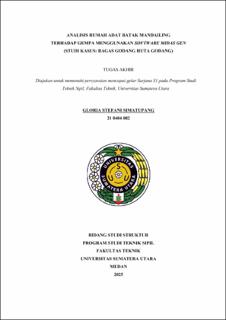Analisis Rumah Adat Batak Mandailing terhadap Gempa menggunakan Software Midas Gen (Studi Kasus: Bagas Godang Huta Godang)
Seismic Performance Analysis of the Batak Mandailing Traditional House using Midas Gen Software: A Case Study of Bagas Godang Huta Godang

Date
2025Author
Simatupang, Gloria Stefani
Advisor(s)
Tarigan, Johannes
Metadata
Show full item recordAbstract
The Batak Mandailing traditional house, known as Bagas Godang, is an important architectural heritage in Indonesia that reflects the local wisdom and traditional craftsmanship of its people. This wooden stilt house is typically constructed using flexible natural materials such as hardwood, bamboo, and thatched ijuk roofing, and is supported by stone foundations without the use of mechanical fasteners. With the increasing seismic threat in Indonesia, which is located in the Pacific Ring of Fire, it is essential to analyze the seismic resistance of the Batak Mandailing traditional house structure.
This study conducts an in-depth seismic analysis of the Bagas Godang house located in Huta Godang using MIDAS GEN, a structural analysis and design software. The analysis is carried out using both the response spectrum method and static analysis, in accordance with the Indonesian seismic code SNI 1726:2019. The study examines various seismic performance parameters, including the identification of the center of mass and center of stiffness, assessment of mass eccentricity, detection of structural irregularities (both vertical and horizontal), evaluation of potential soft-storey behavior, and analysis of internal forces acting on columns, walls, and foundations.
The results show that the Bagas Godang structure exhibits generally adequate seismic behavior. However, the inter-story drift exceeds the allowable limit, although the internal forces remain below the material stress capacities. An uneven mass distribution at the rear part of the building introduces mild torsional effects. While no critical structural irregularities were found, the structure shows a tendency toward soft-storey mechanisms due to open spaces at the ground level. In conclusion, the Batak Mandailing traditional house is not considered fully earthquake-resistant due to excessive inter-story drift and the potential presence of soft-storey mechanisms.
Collections
- Undergraduate Theses [1609]
